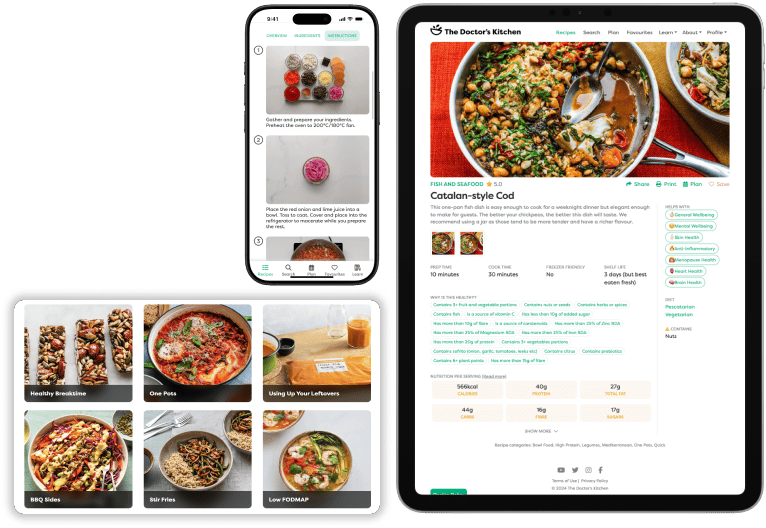Rhubarb: Nutrients and bioactive compounds
23rd Mar 2023
Nothing says spring like rhubarb! Those reddish stalks are the stars of crumbles and pies, and they go great in savoury dishes too. Plus, they’re packed with fibre and polyphenols that have antioxidant and anti-inflammatory benefits.
Key points
In a Nutshell

Save it on Pinterest or download it here.
Plant Tales
Fruit or veg? Some say rhubarb is a vegetable that wants to be a fruit. Scientifically, it is an herbaceous perennial with large edible stalks that appear early in the spring.
A mysterious past: Experts are not entirely sure where the cultivated plant came from. It’s believed to be a hybrid of wild plant species native to Central Asia and Siberia.
Once highly prized: Rhubarb made its way to Europe in the 14th century and was traded alongside silk and pearls. It really took off in the late 18th and 19th centuries when better varieties were developed and sugar became cheaper for sweetening. (National Trust)
Centuries of healing: The rhubarb we eat is just one of about 60 species in the Rheum genus. Called the ‘king of herbs,’ some species have been used in Traditional Chinese Medicine for over 2,000 years to treat constipation, chronic renal failure, acute pancreatitis and gastrointestinal bleeding
What about today?
Health benefits
The key players in rhubarb are:
- Polyphenols – anthraquinones and flavonoids like anthocyanins, which yield its bright red colour. In lab studies, they show beneficial effects on inflammation, cancer-preventive cell signalling and gut function.
- Dietary fibre
- Vitamins K, C & A

In small human trials, rhubarb extract improved:
- Gut health, including transit and ‘beneficial’ gut bacteria in middle-aged participants.
- Regulating inflammation and promoting gut health: Giving rhubarb to patients with sepsis improved their inflammatory markers and gastrointestinal dysfunction, according to a meta-analysis of 15 human trials. (Zhang et al. 2015)
- Blood glucose levels: Two small human trials found that rhubarb extract improved the regulation of blood glucose in diabetic patients. (Shojaei et al. 2018; 2019)
Plus, it’s an extra veggie for the season, adding some diversity to your plate.
Farm to plate

A frosty plant that keeps on giving: Rhubarb is a perennial plant that thrives in cold weather and springs back season after season. Stalks are ready for picking from March for early cultivars, making it one of the first veggies to pop up in the spring! It’s best to stop harvesting by June to avoid weakening the plant.
Undercover rhubarb: Early in the year, you’ll find forced rhubarb. These are early cultivars, grown under pots in the dark, which makes them more delicately flavoured. From late April, maincrop varieties grown outdoors are ready for picking. Their stalks are deeper red, tinged with green and have a more intense flavour.
The UK’s famous ‘Rhubarb Triangle’: An area of West Yorkshire became known as the centre for forced rhubarb, called the ‘rhubarb triangle’. It is now recognised as a Protected designation of origin, meaning that only a handful of growers in the area can use the name, similar to champagne from the Champagne region of France. (National Trust)
Grow your own: Rhubarb is considered easy to grow. It’s best planted in its own space in any corner of the garden where it can grow undisturbed, and it grows well in soil amended with plenty of well-rotted compost. Growing tips.
Ways to enjoy
Cook it up: Studies suggest that cooking rhubarb favours the release of polyphenols and boosts its antioxidant capacity. (Kalisz et al. 2020)
Prep: Cut off the leaves and discard them as they are poisonous due to their high levels of oxalic acid. Wash the stems and chop them into batons or chunks.
- With oily fish like mackerel.
- Rhubarb Stew like Iranian Khoresh Rivas.
- Pickled with vinegar, sugar and spices.
- Sweet crumble with frozen berries, maple syrup, vanilla, a squeeze of lemon and an almond/oat topping.
- Compote – cooked down with a splash of water and spices like cinnamon, ginger or a touch of cardamom.
Recipes
- Access over 800 research backed recipes
- Personalise food for your unique health needs
